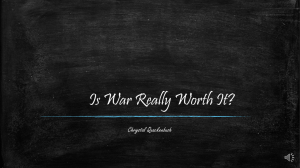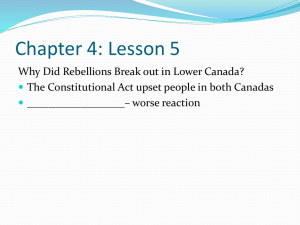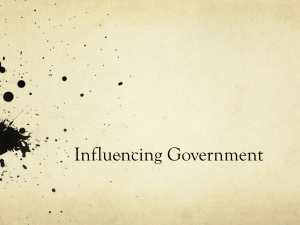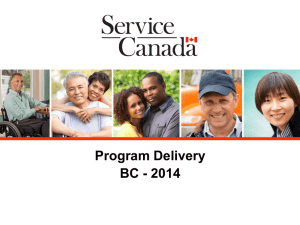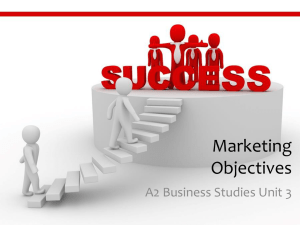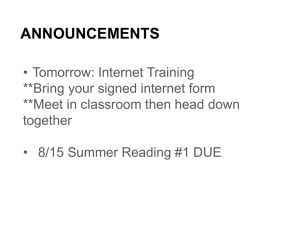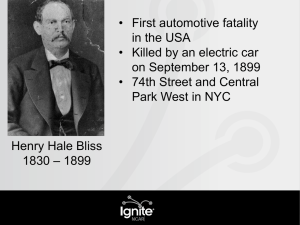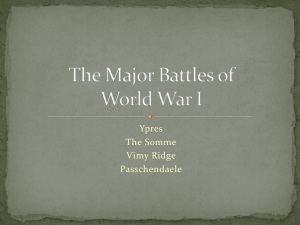What are the Stories of Canada?
advertisement
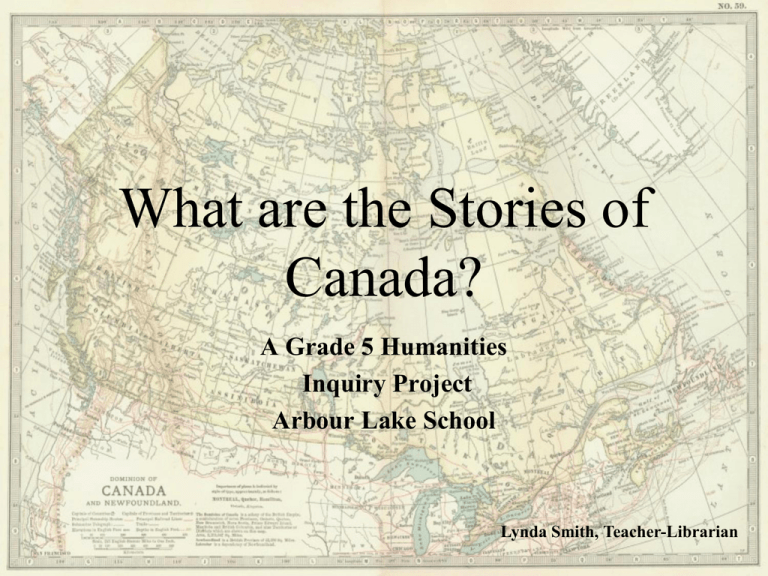
What are the Stories of Canada? A Grade 5 Humanities Inquiry Project Arbour Lake School Lynda Smith, Teacher-Librarian Project Overview • This project was intended to provide an inquiry-based opportunity for grade 5 students to study the stories of early Canadians. • Outcomes from English Language Arts, Social Studies and ICT were imbedded throughout, as well as information literacy skills and strategies (specific outcomes are listed later). • This was a large-scale project that took at least two months to complete. Students worked on the project an average of three to five classes weekly. • Four classes of grade 5 students took part in the project. Two classroom teachers, the technology learning leader and the teacher-librarian were involved in planning and teaching during the project. • Our hope was that students would become ‘experts’ on a group of early Canadians and learn their stories of coming to our country. They would share their learning using Smart Ideas software; others could view their presentations and learn about the stories of Canada from six different perspectives. Curricular Outcomes English Language Arts General Outcome 2 Students will listen, speak, read, write, view and represent to comprehend and respond personally and critically to oral, print and other media texts. General Outcome 3 Students will listen, speak, read, write, view and represent to manage ideas and information. Social Studies 5.2 Histories and Stories of Ways of Life in Canada General Outcome Students will demonstrate an understanding of the people and the stories of Canada and their ways of life over time, and appreciate the diversity of Canada’s heritage. Note: There were numerous smaller outcomes covered in L.A. and Social Studies ; it is not possible to list them in this context. Curricular Outcomes – cont. C.1 - Students will access, use and communicate information from a variety of technologies. C.4 - Students will use organizational processes and tools to manage inquiry. C.5 - Students will use technology to aid collaboration during inquiry. C.6 - Students will use technology to investigate and/or solve problems. F.6 - Students will demonstrate a basic understanding of the operating skills required in a variety of technologies. P.3 - Students will communicate through multimedia. This is a sampling of the ICT outcomes incorporated into the project. Planning Team • Two grade 5 Humanities teachers • Technology Learning Leader • Teacher-Librarian • The basic plan of the project was developed by the teacherlibrarian and the grade 5 teachers. Teaching was shared by the T-L and classroom teachers. • The Technology Learning Leader co-taught specific lessons related to ICT outcomes (e.g. editing photos, creating an audio recording, using the Smart Ideas program) Project Outline – Part 1 • The project was introduced by the teacher-librarian using the book The Quilt of Belonging, by Janice Weaver, as a springboard. We discussed the idea that every person has a story of coming to Canada; we each came at different times in Canada’s history and have a personal and a family story to tell. • Introductory exploration stations were set up about six key groups of early Canadians (French Canadians, Aboriginal Peoples, Fur Traders, Explorers, European Immigrants, Non-European Immigrants) chosen from the Program of Studies. Students were to get a ‘taste’ of the stories and lives of these people from resources such as: picture books, short background readings, diary entries, pictures, video clips and specific websites . ∙ Students were divided into groups; each group spent one class at each station and recorded their learning through pictures and notes. In order to show students that stories could be told many different ways, we modelled using the oral tradition, diaries, news stories , artwork etc. Project Outline – cont. 2 • Each group chose the station they wanted to focus on the most and immersed themselves in many resources to become ‘specialists’ about their chosen topic. • The students brainstormed ideas of what they wanted to learn about their group of early Canadians; as a class they shared their ideas and a set of basic questions was developed. Groups added their individual questions to the basic set and a graphic organizer for note- taking was developed. • Additional information materials were added to the stations and students located their own information books and websites, with guidance. • Students read, viewed, discussed and found answers to their questions. They took point-form notes and cited their sources in a basic reference list. • Steps of the research process were modelled along the way (for example, locating credible information, note-taking and referencing). Project Outline – cont. 3 • Specific ICT-related skills were also taught and modelled throughout the research process. Examples included: how to take, download and edit photographs, how to create audio recordings and insert them, how to take video clips and insert them, how to use Smart Ideas software, and how to scan a document and insert it. • Once groups had collected enough information they discussed how each group member would share their learning on the group’s Smart Ideas slide. Students chose a variety of formats that included: audio recordings of them reading a story or information, video clips of a skit or reenactment of events, diary entries that they ‘aged’ and scanned, letters home, artwork depicting an aspect of the journey that was scanned in. Each of the items was linked to the group’s Smart Ideas page. • Each grade 5 class had their own Smart Ideas set of six pages. Students could see the pages of each group and of the other classes as well. • Once the pages were complete, each group presented their work to the class so that all students could learn about each of the six topics. ∙ Assessment was an ongoing part of each stage of the project. Rubrics were used for notetaking assessment and for the group’s final slide presentation. Student self-reflection was ongoing as well. Results and Reflections • Overall, the project was a success and we felt that the students had rich learning experiences exploring the stories of early Canadians. They responded well to being able to represent their learning in multiple formats using multiple intelligences and to using technology in a number of ways. We were pleased at the large number of curricular outcomes that were incorporated into the project and the enthusiasm that students showed for their learning. • The use of the book, The Quilt of Belonging, helped students to develop a frame of reference for the project. They all knew family stories of where they were from and how their family came to Canada. The classroom teachers used this idea to do additional writing activities with their classes, having students write their family or personal stories of coming to our country. • Our hope was to hold a celebration at the end of the project for parents to come in and see the work the students were doing. Ideally, each group would have presented to the parents. We didn’t manage to have the celebration, but it’s a great idea! • One concern that we had was the length of time that the project took. We had some issues with the stability of the Smart Ideas software and that made the project last longer than we would have liked. More pre-teaching would ensure a smoother project. • An additional area of concern was the large amount of data collected by each group and the challenge of organizing that information for ease of access (flash drives would be very helpful) Results and Reflections – Cont. • The classroom teachers used the project to introduce historical fiction novels to the students. The teacher-librarian book-talked sets of Community of Readers novels that related to the stories of early Canadians. Students chose a novel to read in small groups and the classroom teachers continued this independently. The teachers reported that their students loved the novels and were able to relate to them more than in previous years. Considerations for further incarnations of the project: • Consider eliminating the introductory station exploration time and have students choose their topics based on prior knowledge (would save time). • Consider down-sizing the scope of the project so that each group only added three items to their Smart Ideas group page (working in partners). • Consider using other software (possibly PowerPoint) or explore another platform such as Prezzi. • Try to incorporate more pre-teaching so that the project can proceed more smoothly. For example, if students had already written their personal or family stories of coming to Canada it would have made it easier. Also, if the students were more familiar with the software and various aspects of using the technology, the project would proceed more quickly.
